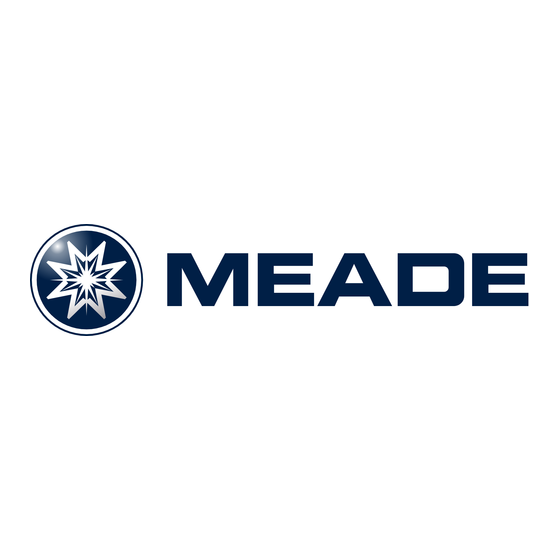
Advertisement
Quick Links
Fig. 1: ACF 0.68x Focal Reducer
Introduction:
The Meade 0.68x focal reducer is designed for use with Me-
ade's Advanced Coma-Free (ACF) telescopes, of any aperture,
using the 2"-24 (2" diameter, 24 threads per inch) rear cell
thread. This rear cell thread is standard on all Meade ACF tele-
scopes. The 0.68x focal reducer consists of 4 lenses in 2 groups
with all air-to-glass surfaces fully multi-coated with broadband
anti-reflection (BBAR) coatings for maximum light transmis-
sion and image contrast. It provides good correction across
a 28mm image circle making it ideal for APS-C sized sensors.
Meade's ACF focal reducer reduces the effective focal length
of the main telescopes optical system by a factor of about
one third. When used with Meade's f/10 ACF, the resulting
effective f/ratio becomes around f/6.8. When attached to
Meade's f/8 ACF, the resulting effective f/ratio will be around
5.5, resulting in a substantially "faster" optical system that
cuts exposure times in half while increasing the field of view.
Fig. 3: Focal Reducer Lens System
The reducers optical design provides full illumination of a 22mm
diagonal image sensor and nearly full illumination out to 28mm,
with just slight vignetting that is corrected with flat field calibra-
tion. It boasts a generous 105mm of back-focus distance to the
image plane, measured from the reducer's flange, or 100mm
on-axis from the last lens, allowing loads of space for imaging
train accessories such as a filter wheel and/or an off axis-guider.
Installation:
To install the focal reducer onto your Meade ACF tele-
Looking at or near the Sun will cause irreversible damage to your eye. Do not point this telescope at or near
the Sun without a proper solar filter attached.
Meade ACF 0.68x Focal Reducer
with 50mm T-thread Adapter
Fig. 2: 50mm T-thread Adapter
Fig. 4: Typical DSLR Configuration
scope, first remove the threaded protective dust cap from
the reducer. Then thread the reducer directly onto the
back cell of the telescope using the 2"-24 TPI threads.
The included T-adapter, with a length of 50mm and an M42x0.75
thread, is well-suited for various applications to achieve the
nominal 105mm back focus required by the reducer. It's suit-
able for use with DSLR cameras equipped with a t-ring, as
well as many cameras with a 55mm depth-to-sensor distance.
For dedicated astronomy cameras, additional adapters (us-
er-supplied) may be needed to reach the reducers nomi-
nal back focus distance. See Fig. 5. Various adapters of dif-
ferent length and attaching thread sizes are available from
third-party suppliers. These additional adapters typically con-
nect to the M42x0.75 t-thread connection at the end of the
included T-adapter and then to your camera or filter wheel.
To determine the length of the additional adapter (if need-
ed), locate the depth-to-sensor distance for your camera.
This is often called the camera backfocus. This is the dis-
tance from the cameras mounting point to the image sensor
and is usually found in the camera instructions or webpage.
Next, measure the distance the other equipment in your
imaging train requires. This includes filter wheels, off-ax-
is guiders, electronic focusers, connecting adapters, and
anything else between the focal reducer and camera sen-
sor. Add up the camera's backfocus distance and oth-
er image equipment distances. This is the total work-
ing distance (X) required by your imaging equipment.
Note: If using the Meade Zero-image Shift microfocuser, the
minimum needed backfocus for this device is 60mm with
the focuser draw tube fully retracted. When using this fo-
cuser, removal of the included 50mm T-adapter is necessary.
Since the focal reducers nominal back focus is 105mm when
measured from its mounting flange, subtract the distance in
mm your imaging equipment requires (X) from 105mm to
get the adapter length (Y) needed to reach nominal focus.
Advertisement

Summary of Contents for Meade ACF 0.68x
- Page 1 2”-24 TPI threads. using the 2”-24 (2” diameter, 24 threads per inch) rear cell thread. This rear cell thread is standard on all Meade ACF tele- The included T-adapter, with a length of 50mm and an M42x0.75 scopes.
- Page 2 Corrected Field of View:..........28mm published at: www.meade.com/supports/warranty/ Optical Coatings:........fully multi-coated A printed copy of the Meade Statement of Limited Warranty will Back Focus Distance: be made available by Meade upon written request. See below for Meade contact information. Flange Distance:..........105mm On-axis Distance:..........100mm...
Need help?
Do you have a question about the ACF 0.68x and is the answer not in the manual?
Questions and answers